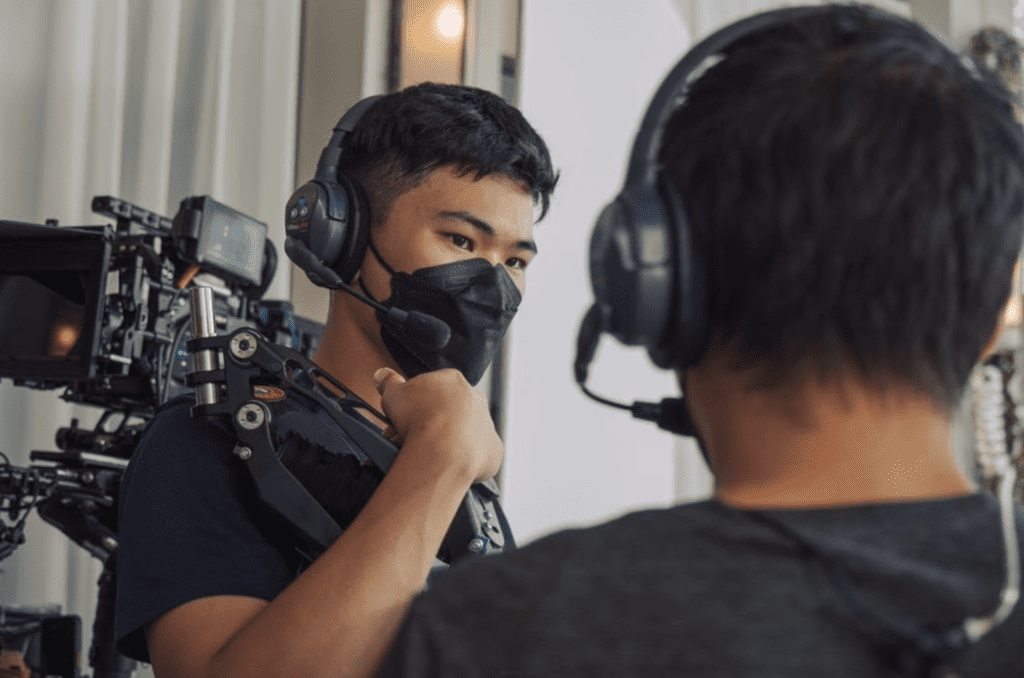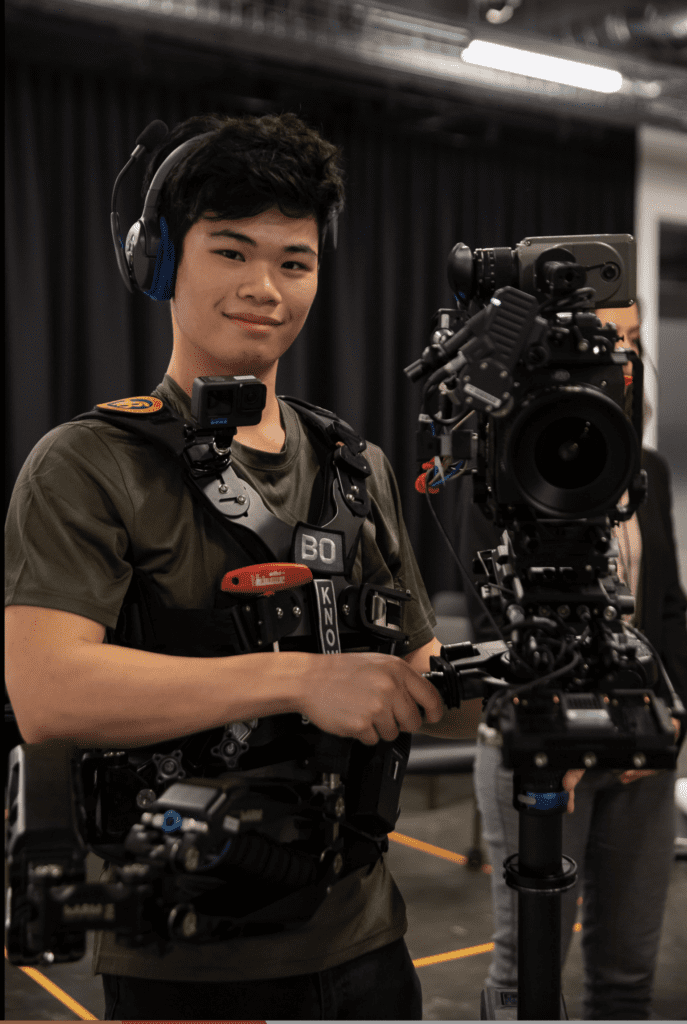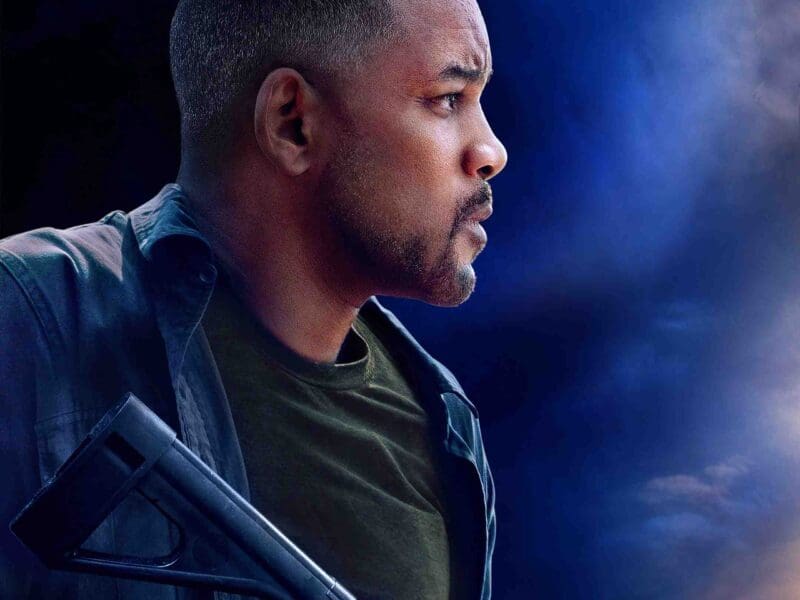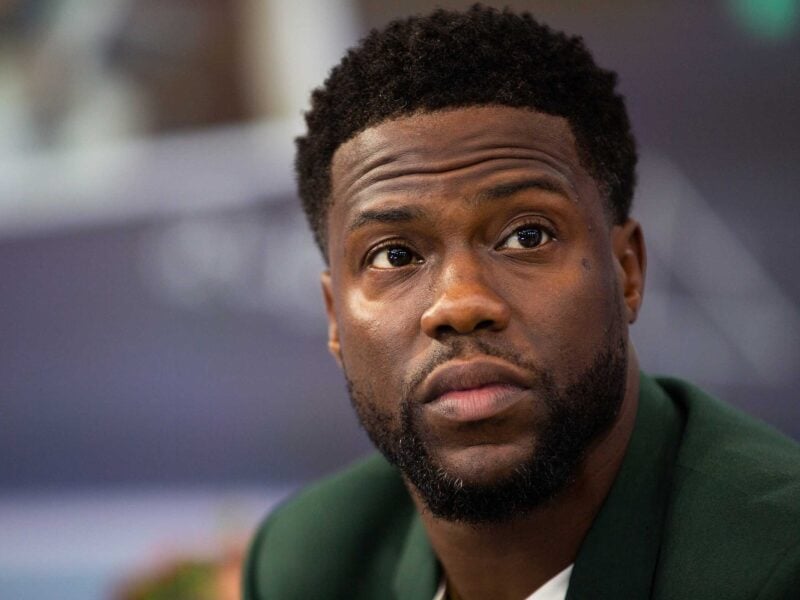
An Interview with Bo-Yu Chen
In the bustling heart of Hollywood, where dreams are woven into cinematic tapestries, few have managed to capture the essence of storytelling quite like Bo-Yu Chen. From the neon-lit streets of Taiwan to the star-studded boulevards of Los Angeles, their journey has been nothing short of cinematic itself.
With a resume that spans genres and continents, they’ve painted emotions with light, crafted narratives that resonate globally, and showcased the beauty of diversity on the silver screen.
Dive into our exclusive sit-down with this master of visual storytelling as we discuss their Taiwanese roots, the nuances of lighting, and the challenges of navigating two distinct film industries. Plus, get a sneak peek into their upcoming projects that promise to be nothing short of showstoppers.

As an established cinematographer, what initially drew you to the art of visual storytelling?
I was introduced to cinematography on a film set where I began as a production assistant. I had the privilege of witnessing different departments work, and it was the cinematographer who left an indelible impression on me. Their commanding presence and ability to craft breathtaking visuals fascinated me, igniting a desire to follow in their footsteps.
My journey into cinematography took off when I transitioned to the grip and electric crew, delving into the world of lighting. As I immersed myself in the art of lighting scenes, I became enamored with the tangible impact it had on visual storytelling.
Learning the nuances of lighting techniques and experiencing firsthand how they shaped the narrative solidified my love for cinematography. Through this journey, I discovered that cinematography is more than just capturing images; it’s about painting emotions and narratives with light, enriching the storytelling experience for both creators and audiences alike.
How do your Taiwanese roots influence your style of cinematography and approach to your work?
While I hadn’t directly worked in Taiwan’s film industry before establishing myself as a DP, the essence of Taiwanese culture, rooted in community and interpersonal connections, has significantly influenced my collaborative approach within the filmmaking realm.
This sense of community and mutual support deeply ingrained in Taiwanese culture, translates seamlessly to a film crew. Just as Taiwan’s ethos emphasizes harmonious coordination, the collaborative nature of filmmaking demands the synchronization of diverse talents.
Drawing from my roots, I place paramount importance on effective communication and teamwork, and I strive to give crew members the opportunity for creative input.
Having navigated both American and Taiwanese cultures, I’ve developed a keen ability to embrace diverse perspectives and think from various vantage points. This skill proves invaluable when engaging in projects involving languages, cultures, or identities with which I might not be intimately familiar.
In your transition from Taiwan to Los Angeles, have you noticed any differences in how cinematography is approached in both regions?
One of the most pronounced distinctions I’ve encountered centers around the pivotal aspect of lighting. In Hollywood, the process of illuminating a scene is predominantly within the realm of a Director of Photography (DP).
Here, the DP wields substantial creative authority over the lighting design, overseeing its intricate details from concept to execution. I often find myself delving into the specifics of lighting by offering precise instructions to the Chief Lighting Technician (CLT), aiming to attain a specific visual mood.
The dynamics shift when I operate within Taiwan’s filmmaking landscape. In this context, the Chief Lighting Technician exercises a more extensive degree of creative influence over the lighting process.
I typically convey the desired visual mood of a scene through broader strokes of communication. Subsequently, the CLT takes the reins, directing their team to craft the scene’s lighting within the parameters we’ve established together.
This variance in approach isn’t solely limited to lighting; it permeates various facets of the cinematographic process. Through my experiences, I’ve come to appreciate that these differences aren’t a matter of one approach being superior to the other. Instead, they represent the beautiful diversity inherent in global storytelling.
As a foreigner working in the Hollywood industry, can you share any challenges you’ve faced and how you’ve navigated them?
The fabric of culture plays a significant role in the film industry, where building and nurturing connections is paramount. While I’m fluent in English, my upbringing in Taiwan has left me with cultural nuances that I’m still learning. The lack of exposure to elements like sports teams, pop culture references, and even humor tied to cultural background knowledge can create barriers in connecting with others.
Amid these struggles, I am actively learning these American cultural intricacies while also recognizing that my Taiwanese background is a valuable commodity that can enrich the American cultural landscape. Despite the challenges, I am forming a community—connecting with like-minded individuals who appreciate diversity and are eager to create an inclusive environment.
Being the first in the family to work in America also comes with unique challenges, particularly in terms of generational support. While I’m fortunate to have parents who’ve supported me immensely, they reside half a world away, in a country with its own distinct culture.
This means that many life experiences and practical knowledge that locals take for granted are areas I must navigate on my own. This includes not only my career but also the intricacies of living in the United States, a process that requires additional layers of adaptation and self-discovery.
When you’re shooting with a Steadicam versus conventional operating, how do you decide which tool will best tell the story you’re trying to capture?
The decision to use either a Steadicam or conventional tools depends on the specific storytelling needs of each project. Steadicam is a tool I opt for when I require movement with flexibility that conventional equipment may not provide.
It excels in situations where I need to navigate through spaces that are challenging for conventional equipment such as dollies to access. Steadicam’s ability to move freely allows me to capture shots from unique angles, which can be especially effective in creating dynamic and engaging visual sequences.
Additionally, the real-time responsiveness of the Steadicam to the actor’s movements is a significant advantage. Unlike a dolly on tracks, the Steadicam operator can fluidly react to the actor’s actions, creating a sense of spontaneity and authenticity in the shot. This quality is invaluable when aiming to capture natural interactions and emotions within a scene.
In essence, the decision to use Steadicam over conventional operating hinges on the need for agile movement and the ability to respond dynamically to the environment and performances. My choice is guided by the storytelling objectives and the visual language that will best enhance the narrative’s impact.

With your experience spanning narrative film, commercials, and music videos, do you approach each medium differently, and if so, how?
My experience spanning narrative film, commercials, and music videos has shown me the diversity and distinct nuances of each medium. What unites them all is the underlying narrative element.
While music videos are often more visually expressive and commercials tend to have product-focused narratives, both still convey emotions and stories that resonate with the audience. This basis in narrative and storytelling is the cornerstone upon which I build my work, making every medium engaging and enjoyable for me.
The difference in approach between narrative work, music videos, and commercials becomes more apparent when considering workflow and visual style:
Narrative:
In narrative projects, characters often drive the story, making character development and emotional arcs central. My approach here is focused on supporting the actors to bring out their performances. I tend to employ more naturalistic and subtle camera movements to create an immersive image that enhances the story’s impact on the audience.
Music Videos:
Music videos often emphasize energy and faster editing, allowing for a more free-form approach. Here, I aim to enhance the song’s energy and performance by incorporating visually dynamic elements. It’s a medium that encourages creative exploration and allows me to experiment with unconventional techniques.
Commercials:
Commercials typically involve meticulously planned execution. Directors and DPs often arrive with specific shot lists that have received client approval. Precision is key in commercials, where fast and accurate execution of shots is valued. The process involves accommodating client requests swiftly and adhering closely to the established plan.
Your latest project, “Don’t Let Me Stay,” seems to delve into the horror genre. How do you approach capturing the atmosphere and tension inherent in this genre?
This project places a significant emphasis on character development, with the primary objective being to intimately unravel the unsettling backstories each character carries. The house itself assumes a character-like presence, both ensnaring the characters within its confines and enticing them to confront their own histories.
Given the constraints of a limited budget, we approached the location creatively to evoke a sense of abnormality and unease. Instead of making drastic changes, I employed subtle touches to give the house an unsettling aura. I employed a specific gel to cast an off-kilter and subtly disturbing tint on the colors of the lamps scattered throughout the house. These subtle alterations worked to convey an uncanny and eerie atmosphere.
Given the character-centric nature of the project, I utilized unconventional camera movements to enhance the psychological tension. For certain scenes, I intentionally adopted a “swimmy” Steadicam look, injecting a sense of instability into the visuals.
In another impactful instance, the director and I designed a deliberately slow three-minute dolly in during a character’s monologue, immersing the audience in their introspection and adding to the sense of creeping dread.
The premise of “Don’t Let Me Stay” is quite intriguing. What were your primary visual inspirations when creating the cinematographic vision for the film?
The visual direction had to effectively convey the unsettling tension and the house’s underlying malevolence. A significant source of inspiration for our visual approach was the acclaimed Netflix series “The Haunting of Hill House.” The show’s distinctive elements, including abnormal colors, unconventional lighting, and creepy camera movement, left a profound impact.
The use of abnormal colors and lighting played a pivotal role in setting the film’s tone. The deliberate manipulation of colors and lighting heightened the otherworldly atmosphere within the house, contributing to the audience’s sense of discomfort and intrigue.
We also leveraged dynamic camera movements in certain scenes to underscore moments of tension and revelation. This technique allowed us to immerse the audience in the characters’ experiences while conveying the eerie unpredictability of the house itself.
Moving from horror to comedy with “Attached,” how did you manage to visually represent the humorous yet dark themes?
The premise, revolving around a college student’s struggle with a gruesome consequence of his cell-phone fixation during a crucial exam, creates a remarkable juxtaposition of terror and absurdity.
In comedy, timing is everything. For “Attached,” the essence of humor was rooted in revealing the absurd at precisely the right moments. Scenes featuring grotesque yet humorous situations were carefully framed and timed to maximize the impact of this irony, evoking laughter alongside unease.
Working closely with director Xingyu Harry Chen, we devised dynamic framing and camera movements that amplified both the horror and comedy aspects. These visual choices created a distinct atmosphere, allowing the narrative to fluidly transition between dread and laughter.
“J.I.A. Justice Intelligence Agency” sounds like a politically charged piece. How did your role as Director of Photography contribute to bringing these themes to life?
While the narrative addresses racial tensions and justice, I aimed to engage the audience through dynamic visuals, immersive action sequences, and a cohesive cinematic experience.
Collaborating closely with Director Domonick Jones, my approach was to ensure the audience becomes emotionally invested in the characters’ journeys, enhancing the overall engagement. I wanted to capture the viewers’ attention through visual techniques such as energetic camera movement and well-choreographed action.
Considering your award-winning work on “Attached,” what, in your view, made this project stand out from the crowd?
Guided by Director Xingyu Harry Chen’s vision, we embarked on a creative journey to bring this unique concept to life.
Through a harmonious blend of body horror and comedy, carefully crafted visuals, and collaborative efforts, the film succeeded in leaving a lasting impression that resonated with viewers on both an emotional and comedic level. This ingenious twist on a familiar topic lent the film a memorable quality that distinguishes it from the rest.
Can you talk about any specific visual decisions that led to the recognition of “Attached” as the Best Dark Comedy Short at the IndieX Film Festival?
A crucial visual decision was maintaining a consistent clinical, dark, and disturbing visual tone throughout the film. This choice set the stage for the unique comedic premise of phones being physically attached to the body.
Framing and composition was also a big element in making this project stand out. Carefully orchestrating the gradual merging of the phone with the body (spoiler alert), we strategically revealed select glimpses while shrouding other details, crafting an atmosphere of mystery and impending dread.
The culmination of these choices captured the film’s distinct blend of dark comedy, leaving an indelible impression that set it apart within its genre and earned its recognition.
How do you approach your collaboration with directors and producers on a project, particularly with those who share the recognition of your award-winning projects?
Collaboration with directors and producers is a big element of being a cinematographer, and my best work often is created within a tight-knit circle of frequent collaborators. Our shared history and deep understanding of each other’s strengths create a foundation of trust that greatly enhances our creative endeavors.
Beginning by immersing ourselves in the project’s distinctive essence, we engage in open dialogues about themes, tone, and emotional resonance. This familiarity allows me to tailor my cinematographic approach to seamlessly align visuals with their storytelling goals, preserving the collaborative spirit that sets our circle apart.
Having been recognized with multiple awards, how does that recognition influence your approach to future projects?
While I value and take pride in the recognition that both I and my collaborators receive for our work, I want to emphasize that my approach to projects remains steadfastly focused on the art of storytelling itself. My foremost commitment is to invest 100% into every project I undertake, ensuring that I wholeheartedly serve the narrative, enhance characters and storytelling, and faithfully bring a director’s vision to life.
The recognition we receive serves as a validation of the methodologies I employ. It affirms that the dedication, attention to detail, and collaborative efforts that I pour into each project contribute to its success. This validation fuels my motivation to continue pursuing excellence in my work, irrespective of external acknowledgments.
Your filmography seems to exhibit a willingness to explore multiple genres. How do you adapt your visual storytelling techniques to different narratives?
I find excitement in the prospect of crafting distinct visual styles that align with each genre’s unique tone. Navigating this journey involves a blend of visual research, collaborative brainstorming with directors and creative teams, and a deep respect for the essence of each narrative
In my pursuit of adapting visual storytelling techniques, I embark on a process of visual research that delves into the established visual language of the specific genre. This research acts as a foundation upon which I can build, offering insights into genre-specific motifs, lighting approaches, and camera techniques.
This knowledge serves as a springboard for brainstorming sessions with directors and the creative team. Together, we explore innovative visual concepts that can elevate the narrative and immerse audiences more deeply in the story’s world.

How do you feel the industry’s reception to Asian filmmakers has evolved during your career, and what challenges remain?
While my time in the industry has been relatively short, I can observe that there have been significant changes in the reception to Asian filmmakers. Diversity and inclusion have become prominent discussions within the industry, reflecting a shift towards more open and accepting perspectives.
Racial diversity remains a pressing issue, even though strides have been made. The conventional image of a cinematographer often aligns with a white male figure. This reality sometimes translates into differing perceptions of opinions, with those of white males carrying more weight than those of other demographic groups.
As an Asian cinematographer, I’ve observed that Asians can sometimes be marginalized within minority circles, further complicating the pursuit of inclusivity.
Compared to the past, the industry’s acknowledgment of Asian filmmakers has indeed improved, with a greater emphasis on diversity. However, challenges persist, particularly when it comes to perceptions around roles like cinematography. Despite the positive shifts, these struggles remind us that there’s still work to be done in dismantling preconceived notions and fostering a truly inclusive industry landscape.
What advice would you give to other Asian cinematographers or filmmakers looking to make their mark in Hollywood?
- Excellence and Professionalism: Dedicate yourself to producing exceptional work. By showcasing Asians in leading roles and consistently delivering high-quality results, you actively contribute to altering perceptions..
- Overcoming Struggles: Instead of succumbing to victimhood, tackle challenges head-on. Recognize that the world isn’t flawless, and focusing on overcoming obstacles is far more empowering than placing blame.
- Embrace Your Diversity: Resist the urge to conform to expectations. Embrace your cultural diversity, especially if you’re from another country. Our unique backgrounds enrich the industry’s diversity.
- Challenging Stereotypes: While being Asian can pose challenges, remember that these hurdles are not insurmountable. Most individuals hold nuanced or no discriminatory views, and your expertise can swiftly disprove any preconceptions..
- Seizing Opportunities: Embrace opportunities tailored to Asian talents. The industry’s current emphasis on diversity provides a platform for you to shine. Even if you’re presented with an opportunity that feels like a “diversity hire,” remember that it’s a chance for you to leave an indelible mark.
- Promoting Inclusion: As you ascend within the industry, use your influence to advocate for diversity in crew selection. By actively promoting the hiring of a diverse range of talents, you contribute to fostering a more inclusive and representative environment.
Can you share any passion projects or dream scenarios you’re hoping to explore in your future work?
Absolutely, I hold a dream of bringing forth a project that beautifully weaves together the essence of Taiwanese identity, broader Asian cultures, or the narratives of Asian immigrants.
This project would be propelled by a captivating story and compelling characters that resonate universally, making it a global sensation. Such an endeavor would not only elevate the appreciation for my cultural heritage but also offer a profound connection to personal identity and shared experiences.
And of course, have much love between all cast and crew, unlimited budget, unrestricted schedules, and control of the sun.
Ultimately, this aspiration embodies my desire to create something deeply meaningful, artistically resonant, and globally impactful. By harnessing the power of storytelling, my dream project aims to celebrate cultural heritage, spark dialogues, and unite people through the universal language of cinema.
As an LA-based filmmaker, do you see yourself returning to work in Taiwan or Asia more broadly, and why or why not?
My upbringing has shaped me into a global citizen, and my aspiration as a filmmaker is to follow the path of meaningful projects, regardless of location. Drawing inspiration from mentors who have ventured across the globe, I hold the dream of attaining a level of excellence that would prompt productions to engage my team and me for projects spanning different corners of the world.
My ultimate goal is to be a storyteller without borders, collaborating with diverse talents to craft narratives that resonate universally. Embracing this mindset allows me to contribute my unique perspective to projects that may unfold anywhere, whether it’s LA, Taiwan, Asia, or beyond.
By pursuing this approach, I envision a future where my creative journey takes me to places where storytelling knows no limits, enriching my craft and enabling me to create impactful stories that transcend geographical boundaries.

Lastly, what’s next for you? Are there any upcoming projects you’re particularly excited about that you can share with us?
I have a range of upcoming projects that are currently in post-production and festival runs, and I’m eagerly anticipating their release. Among these, three of my recent projects as Director of Photography—namely, “Flatulence” directed by Xingyu Harry Chen, “Upstream” directed by Yintao Gong, and “Mom is Visiting” directed by Meixuan Li—recently premiered at the LA Shorts International Film Festival.
This festival holds the distinction of being both BAFTA and Academy Award qualifying, and is one of the largest and most prestigious short film festivals globally. I’m excited to witness their journey and see where they’ll be screened next, as they make their way through other renowned film festivals.
Looking ahead, I’m also particularly enthused about some upcoming Steadicam projects. One of them is an action film helmed by the Le brothers, who are not only accomplished actors but have also contributed their skills to major productions like the Oscar-winning “Everything, Everywhere, All At Once,” as well as Marvel Studios’ “Shang Chi.”
Additionally, I’m involved in a drama directed by Chan Jang that delves into the Korean experience during the 1992 LA riots, featuring the acclaimed South Korean actor Lee Won-Jong in a lead role. These projects promise to showcase diverse narratives and dynamic visuals, and I’m excited to see the final product and share them with the world.







